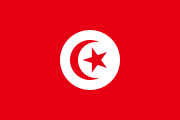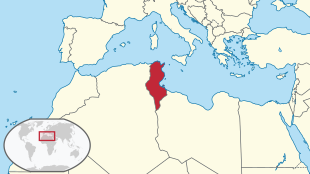Kingdom of Tunisia
| المملكة التونسية (Arabic) Royaume de Tunisie (French) |
|||||
|
al-Mamlaka at-Tūnisiya (Arabic) |
|||||
| Kingdom of Tunisia | |||||
| 1956-1957 | |||||
|
|||||
| Official language | French and Arabic | ||||
| Capital | Tunis | ||||
| Form of government | Constitutional monarchy | ||||
| Head of state | King Mohamed VIII. El-Amine | ||||
| Head of government | Prime Minister Habib Bourguiba | ||||
| currency | Tunisian Franc | ||||
| founding | March 20, 1956 | ||||
| resolution | July 25, 1957 | ||||
| National anthem | as-Salam al-Bey | ||||
| Location of the Kingdom of Tunisia in North Africa | |||||
The Kingdom of Tunisia ( Arabic المملكة التونسية al-Mamlaka at-Tūnisiya 'Kingdom of Tunisia', French Royaume de Tunisie ) was a short-lived state that wasestablishedas a monarchy on March 20, 1956 after Tunisia's independenceand existed until the republic was proclaimed on July 25, 1957. The king was Lamine Bey , Prime Minister of the actual state founder of Tunisia, Habib Bourguiba (Habib Abu Ruqaiba).
history

A movement of independence that lasted for several decades led to the end of the French protectorate, which began in 1881. In 1954, the Tunisian struggle and continued civil disobedience led to the start of negotiations for autonomy between France and the Neo Destur party under Habib Bourguiba , supported by the Tunisian unions and the Arab League . The agreed convention of April 1955 stipulated that France would retain control of the army and foreign affairs, while at the same time guaranteeing the independence of the Beyliks Tunisia, which was to begin the following year. Habib Bourguiba, who had taken the Turkish state founder Mustafa Kemal Ataturk as a model, was released from prison by France and welcomed enthusiastically by the Tunisian people. This compromise, however, split the Neo-Destur and ultimately led to the suppression of its left wing and the exclusion of its radical pan-Arab chairman Salah ben Youssef , who later fled to Egypt . This consequence of the internal party disputes signaled that the Neo-Destur would take a moderate path. The French also ended their patronage over Morocco in order to concentrate their forces on Algeria . In response, and as a result of Tunisian public opinion, Bourguiba pushed for independence. The French government defied the sharp rejection of the French settlers, resigned Tunisia and signed the protocols. On March 20, 1956, Tunisia gained full independence. Tunisia's application for full membership in the United Nations was accepted in July .
According to France, the independent Tunisia became a constitutional monarchy , which was to be ruled by the Bey of Tunis , Lamine Bey (actually Mohammed VIII. El-Amin). The Bey was an institutional title dating back to the early Ottoman era . The previous Bey Mohammed VII el-Monsef was a popular nationalist, but Lamine Bey was seen by some as a compromise by the French and by others as a Youssefist . Already planned elections were held with the election to the Constituent Assembly on March 25, 1956; because of secret agreements negotiated between Bourguiba and the Bey, voters could only vote for party lists and not for candidates. This agreement made it easier for the Neo-Destur to keep Youssefists or other dissidents out and to maintain party discipline. The elections were won by the Neo Destur party with an overwhelming majority, its chairman Habib Bourguiba became prime minister. On July 25, 1957, the monarchy was abolished, the office of Beylik ended and the Tunisian Republic proclaimed. The assembly then made Bourguiba the first president, who would later become a one-party state under the new Socialist Destur party .
See also
Individual evidence
- ↑ Cf., Geyer, Tunisia (London: Stacy 2003) on p. 41. Geyer notes the “pyramidal structureı of the Neo Destour, nonetheless she praises Bourguiba's flexibility and moderationı”.
- ↑ Kenneth J. Perkins, A History of Modern Tunisia (Cambridge University 2004) on SS 125–129, 131–133.
- ↑ Lisa Anderson, The State and Social Transformation in Tunisia and Libya, 1830-1980 (Princeton University 1986) at pp. 231-235.
- ↑ Ivan Hrbek, "North Africa and the Horn" 127-160, at 129-132, (in the section "The struggle for political sovereignty: from 1945 to independence"), in Ali A. Mazrui, editor, General History of Africa. VIII Africa since 1935 (UNESCO 1993).
- ↑ Jane Soames Nickerson, A Short History of North Africa (New York: Devin-Adair 1961) at pp. 162-165.
- ↑ Richard M. Brace, Morocco Algeria Tunisia (Prentice-Hall 1964) at pp. 114–116, 121–123.

